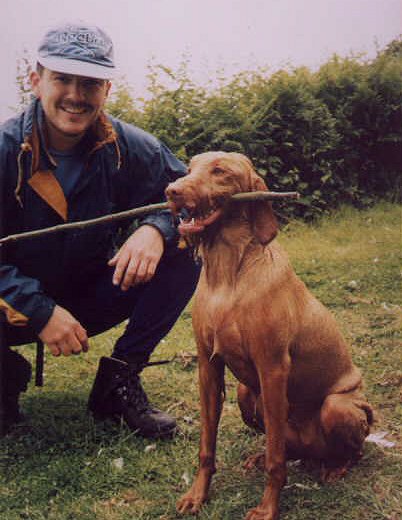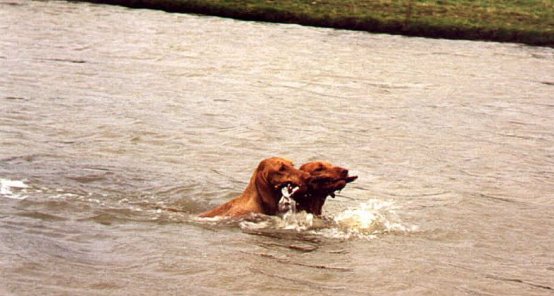About the Breed
Breed Standard
Home Page
About Me and the Dogs
View Our Dogs
History of the Breed
History of the Breed in the United Kingdom
The breed at work -
Shooting
Falconry
Deer Stalking
Pictures of friends' dogs
Puppy rearing
Variations in Coats
General Information
Links to Other Gundog Sites
| They are part of the HPR (Hunt, Point, Retrieve) in the
gundog group. They are very versatile and work as well in water as on land.
They are becoming popular on shoots due to their steadfastness and quick
learning ability.
Personally, I have found temperaments are excellent. They are sweet-natured, good with children and the elderly and with other breeds of dogs, and they have character!! They are fairly easy to care for; as the coat does not need a lot of attention, unless it is softer in which case it would require stripping. General CareA puppy would require only a garden to play in but as they grow older more exercise should be introduced gradually until an adult would be having between one and two hours a day free running, and/or several miles of road walking. Socialisation is important from the start and some early basic working gundog training may be done as early as four months, with simple commands and whistle. Puppy socialisation classes are advisable from 10-12 weeks in order to get the puppies used to interactions with other animals, people and children, then they can go on to whatever other training is appropriate such as ringcraft, obedience, etc. Working training would not start until the puppy was more mature and bone growth was completed. We have found that they are very easy to train and are biddable and eager to please. |
BreedStandard
General Appearance Medium sized, wire coated, distinguished appearance, with a more robust build and a stronger bone structure than the shorthaired vizsla.
Characteristics Loyal, intelligent, obedient, sensitive, very affectionate and with patience easily trained. Bred for hunting fur and feather, pointing and retrieving from land and water.
Temperament Lively, gentle mannered and demonstratively affectionate.
Head and Skull Lively and intelligent expression. Skull moderately broad and slightly rounded, well proportioned and a little longer than muzzle, with moderate stop. Lips covering jaws completely and neither loose nor pendulous. Bridge of nose is straight and ends in a broad nose. The colour of the nose is harmonious with the coat colour. Coat covering the head gives the head a somewhat square striking appearance.
Eyes Neither deep nor prominent, of medium size and slightly oval in shape. Eyelids fitting tightly. Colour of eyes harmonises with coat colour, slightly darker shade desired. Yellow or black eye undesirable.
Ears The ears are of medium set, proportionately long with a thin skin and hanging down close to cheeks. Rounded "V" shape, not fleshy.
Mouth Sound and strong white teeth. Jaws strong with perfect, regular and complete scissor bite, i.e. upper teeth closely overlapping lower teeth and set square to the jaws. Full dentition desirable.
Neck Well muscled and of moderate length, slightly arched and devoid of dewlaps.
Forequarters Shoulders well laid and muscular, elbows close to body and forelegs straight. Forearm long, pasterns upright.
Body Strong and well-proportioned, slightly longer in body measured from point of shoulder to point of buttock, than in height from withers to ground. Level back, slightly sloping croup rounded off towards tail set. Chest strongly developed, deep and reaching at least to the elbows. Ribs moderately well sprung and carried well back.
Hindquarters Straight when viewed from rear, thighs well developed with moderate angulation, hocks well let down.
Feet Slightly oval with toes short, arched and tight. Nails short, strong and a shade darker than coat.
Tail Moderately thick and tapering towards the end, slightly low set. Customarily one third docked. When moving carried horizontally.
Gait/Movement Animated, flowing and ground covering, with a strong rear driving action.
Colour Golden sand to russet. Small white marks on chest and feet should not be penalised.
Coat The wire coat on the neck and body is harsh and close fitting, up to 4 cms. (1 1/2 ins.) long, with an undercoat, which is normally heavier in winter. The hair on muzzle is short and coarse, the hair forming a small beard on the chin. The skull is covered by short, dry hair. Hair on the ears is short and fine. The eyebrows are dense. The coat is shorter on the lower part of the legs, chest and belly. Longer hair is permitted on the rear of the legs. On the feet and between the toes the hair is softer and shorter. Coat on the tail is dense and stronger.
Size Height: Dogs: 58-62 cms. (23-24 1/2 ins.), Bitches: 54-58 cms. (21 1/2 -23 ins.). Variance of less than three centimetres is permitted as long as the dog remains in proportion.
Faults Any departure from the foregoing points should be considered a fault and the seriousness with which the fault should be regarded should be in exact proportion to its degree.
Note Male animals should have two apparently normal testicles fully descended into the scrotum.
Where to see them
Wires can be seen at all the major shows with classes and if you go to http://www.ourdogs.co.uk/ and click on "Show Calendar" in the left hand column you can see the dates of all the shows and where each show is held. You will be sure of getting a wonderful welcome from the Wires and their owners.'

Silvanus Enchantress is doing very well in gundog work
This document maintained by
Irishhounds@aol.com.
Material Copyright © 2001 Wirevizslas@aol.com

